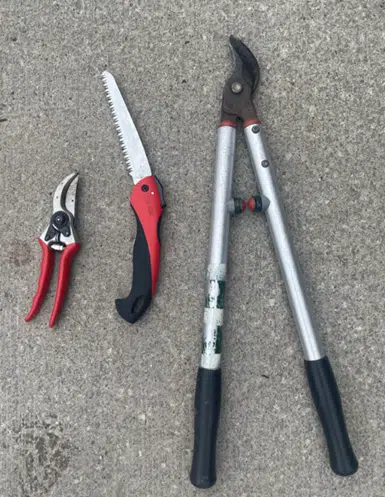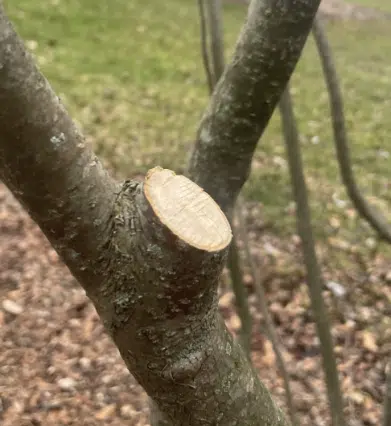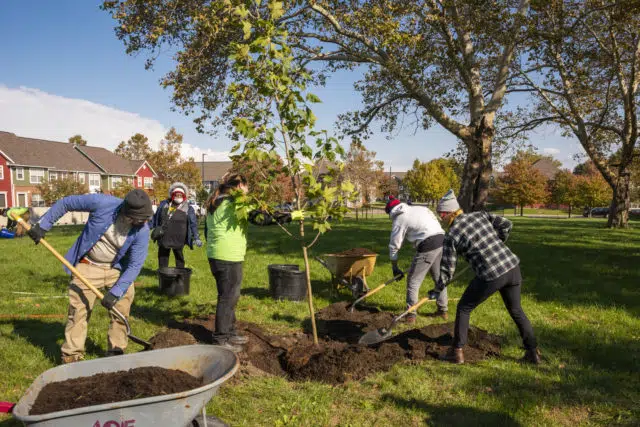
Pruning is a must know when it comes to tree and garden care, but why? Pruning often rejuvenates plants and allows them to grow more efficiently. Taking off old growth can open up the canopy to allow more air flow and direct sunlight to new growth. Pruning off dead wood or extra weight can also alleviate stress on the tree and allow it to allocate resources to more important areas. Finally, pruning is a great way to make trees or woody shrubs look nicer and more shapely for one’s garden if they so desire. The winter season is a great time to prune because many species are not in the growing phase. This means that the plant can focus their resources on healing the pruning cut rather than transporting water and growing. Knowing how to properly prune is key to the plant’s health.
Using the correct tools for pruning is essential. A hand saw, loppers, and hand pruners are all efficient, effective, and easy to use. You want to make sure that your tools are all sharp and will cut through wood with ease. It’s also a good idea to disinfect your tools before and after you use them for pruning. This will cut down on the possibility of carrying an infection from one tree to another accidentally. If areas need pruning that are not reachable, a pole saw or pole pruner are both great tools for reaching up high. They do tend to take a bit more practice and skill to use though.
When beginning to prune, you should look at your plant as a whole. Identify any areas where limbs touch each other and create undesirable rubbing. Look for dead wood. Look for new growth that might create problems as they mature. As a rule, you don’t want to take off more than 1/3 of the canopy, to not damage the plant too much. Taking off older, larger growth and keeping younger growth is a great way to rejuvenate the plant. Start planning out what you want to take off and what you want to keep.
You want to make all of your cuts at a junction. Cutting off wood in the middle of the limb means that the tree will not be able to heal around the cut easily and efficiently. Making your cut at the branch collar will ensure that the tree can properly heal around the wound and seal it off from infection or insects. If you are cutting a limb or trunk to the ground, you want to cut it as close to the ground as you can. When pruning smaller shrubs or trees, a clean cut straight through the wood at the branch collar should be sufficient. However, if you’re cutting a larger limb that has a lot of weight on it, a three-way cut would be the way to go. A three-way cut is made so that when the tree limb falls off as it is cut, it won’t peel back the bark. First, farther down on the branch, you want to make one cut about ¼ to 1/3 through the limb on the underside. Next, you should move down the branch 1-2 inches and make a full cut straight down. For the final cut, make a straight cut at the branch collar once enough weight has been taken off.
This winter at the Arboretum, I’ve been working on pruning in the Butterfly Garden. We started cleaning up a patch of Winterberry, rejuvenating a couple Spicebushes, and cutting back our Bayberry. Pruning can be the life or death of your plant, so knowing the tools and techniques is critical! Take your time and really think about the process. A great way to get out and practice is searching for local classes or volunteer opportunities in your area where you can get hands on experience with tree stewardship. Happy pruning!

Maggie Billings
Native Plant and Pollinator Specialist, AmeriCorps Member
I am an AmeriCorp member serving at the Holden Arboretum in the Butterfly Garden and the Wildflower Garden. Before AmeriCorp, I started at the arboretum as a seasonal in the collections department doing grounds work and assisting the arborists with day-to-day tree tasks. I love all things outdoors including hiking, exploring, biking, and golfing. You can usually find me in one of the gardens or in the horticulture building.
















